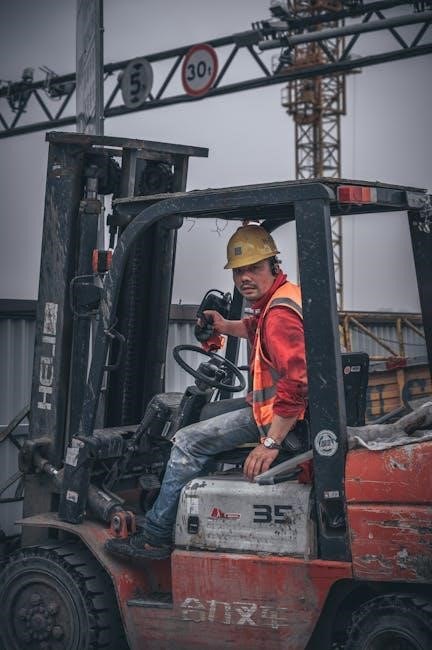Manual handling involves transporting or supporting loads by hand or bodily force, including lifting, lowering, pushing, pulling, or carrying. It is a common workplace activity that, if performed incorrectly, can lead to injuries. The Manual Handling Operations Regulations 1992 provide a framework to minimize risks, emphasizing risk assessments and employer responsibilities. Understanding proper techniques and adhering to guidelines is essential for ensuring safety and compliance.

Regulations and Legal Framework
Manual handling is governed by the Manual Handling Operations Regulations 1992 (MHOR) and the Management of Health and Safety at Work Regulations 1999. These regulations require employers to assess manual handling risks, implement control measures, and ensure a safe working environment to reduce the risk of injury.
2.1 Definition of Manual Handling
Manual handling refers to any activity where a person transports or supports a load by hand or bodily force. This includes lifting, lowering, pushing, pulling, carrying, or moving a load. Under the Manual Handling Operations Regulations 1992, it involves tasks where the load is handled manually, posing potential risks to the individual. The definition emphasizes the use of physical effort to manage or move objects, highlighting the need for safe practices to prevent injuries.
2.2 Overview of the Manual Handling Operations Regulations 1992
The Manual Handling Operations Regulations 1992 aim to reduce the risk of injury from manual handling tasks. Employers must assess risks, implement controls, and provide training. The regulations emphasize avoiding hazardous tasks where possible and using a hierarchy of controls. They also require employers to take into account factors such as the task, individual capability, load characteristics, and the working environment (TILE factors) to ensure safe manual handling practices are adopted.

Risk Assessment Process
The risk assessment process involves systematically evaluating manual handling tasks to identify and minimize risks, focusing on the TILE factors to prevent work-related injuries effectively.
3.1 Understanding TILE Factors
TILE factors are crucial in assessing manual handling risks. Task involves the nature of the activity, Individual considers worker capability, Load examines weight and size, and Environment assesses workplace conditions. Evaluating these elements helps identify hazards and implement control measures to reduce injury risks, ensuring a safer working environment through systematic evaluation and targeted interventions.
3.2 Conducting a Risk Assessment
Conducting a risk assessment involves identifying and evaluating hazards in manual handling tasks. Begin by observing the task, consulting workers, and reviewing incident records. Assess the task’s demands, individual capabilities, load characteristics, and environmental factors. Prioritize risks, implement control measures, and monitor effectiveness. Regular reviews ensure ongoing safety, adapting to changes and reducing injury risks through a systematic and proactive approach.
Employer Responsibilities
Employers must conduct risk assessments, implement control measures, and provide training to ensure safe manual handling practices. They are responsible for compliance with regulations and fostering a safe work environment.
4.1 Implementing Control Measures
Control measures are essential to minimize risks associated with manual handling. Employers should first aim to avoid hazardous tasks where possible. If unavoidable, engineering controls like mechanical aids or adjustable workstations should be introduced. Administrative controls, such as safe lifting practices and training, also play a key role. Regular monitoring and reviews of these measures ensure ongoing effectiveness and compliance with regulations.
4.2 Providing Training and Resources
Employers must provide comprehensive training on manual handling techniques, risk assessments, and the use of equipment. Training should include practical demonstrations and cover specific tasks relevant to the workplace. Resources such as instructional materials and safety guides should be readily available. Regular updates and refresher courses ensure employees remain competent and informed, aligning with legal requirements and promoting a safe working environment.

Employee Responsibilities
Employees must follow safe manual handling practices, report hazards, and use provided equipment correctly. They should attend training sessions and adhere to workplace guidelines to ensure safety.
5.1 Following Safe Practices
Employees should adopt proper lifting techniques, keeping loads close to the body and avoiding back twisting. They must use appropriate equipment and follow workplace guidelines to minimize risks. Regular training ensures awareness of safe practices, reducing the likelihood of injuries. Adherence to these practices is crucial for maintaining a safe working environment and complying with regulations. Employers provide resources to facilitate this compliance effectively always.
5.2 Reporting Hazards
Employees must promptly report manual handling hazards to their employers. This includes unsafe practices or equipment. Reporting ensures risks are addressed, preventing potential injuries. Workers should use designated reporting channels and provide detailed information about hazards. Employers are then required to investigate and implement corrective actions. Regular health surveillance and hazard reporting contribute to a safer workplace, aligning with legal obligations under the Manual Handling Operations Regulations 1992.

Control Measures
Control measures include engineering solutions like lifting aids and mechanical devices, as well as administrative actions such as training, risk assessments, and safe work practices to minimize risks.
6.1 Engineering Controls
Engineering controls are physical solutions to reduce manual handling risks. These include mechanical aids like hoists, conveyors, and lifting equipment. Adjustable workstations and ergonomic tools also minimize strain. Employers should prioritize these measures to eliminate or reduce hazardous tasks. Proper equipment selection and maintenance are crucial to ensure effectiveness. These controls align with the TILE factors (Task, Individual, Load, Environment) and are often the most effective way to prevent injuries. Training on equipment use is essential for safety.
6.2 Administrative Controls
Administrative controls focus on managing work processes to reduce manual handling risks. These include implementing safe work practices, training programs, and job rotation. Employers can establish policies like load weight limits and task rotation schedules to minimize strain. Supervision and regular monitoring ensure compliance with safety protocols. These measures complement engineering controls by addressing how tasks are performed, reducing the likelihood of injuries without altering the physical environment directly.

Training and Competence
Effective training ensures employees understand safe manual handling techniques. Competence is verified through assessments, ensuring staff can perform tasks safely and efficiently, reducing injury risks.
7.1 Essential Training Topics
Training should cover the legal framework, risk assessment using TILE factors, and practical techniques for safe lifting, pushing, and pulling. Employees must learn to evaluate loads, use equipment properly, and adopt ergonomic practices. Understanding individual capabilities and workplace environments is crucial. Training also includes recognizing early signs of musculoskeletal disorders and reporting hazards. Practical demonstrations and assessments ensure competence, reducing the risk of injuries and ensuring compliance with regulations.
7.2 Evaluating Competence
Evaluating competence involves assessing whether employees can safely perform manual handling tasks. This includes observing practical demonstrations, conducting quizzes, and reviewing workplace performance. Employers must ensure employees understand risks and can apply proper techniques. Competence checks confirm that training has been effective and identify areas for improvement. Regular reassessments are necessary, especially after changes in tasks or equipment, to maintain safety standards and compliance with regulations.

Health Surveillance
Health surveillance involves monitoring employees’ physical condition to prevent work-related injuries. It ensures workers are fit for manual handling tasks, reducing risks and promoting workplace safety.
8.1 Monitoring Employee Health
Monitoring employee health is a crucial step in preventing work-related injuries. Employers must assess workers’ physical capabilities and regularly check for signs of musculoskeletal disorders (MSDs). This proactive approach helps identify risks early, ensuring tasks are adjusted to individual capabilities. Regular health check-ups and maintaining employee records are essential. Employers should also provide guidance on reporting discomfort or pain, ensuring a safe working environment and promoting overall well-being.
8.2 The Role of Health Surveillance
Health surveillance plays a vital role in identifying early signs of work-related ill health, particularly musculoskeletal disorders (MSDs). It involves monitoring employees’ physical conditions to detect potential risks associated with manual handling tasks. Employers use this data to implement preventive measures, ensuring tasks are adapted to individual capabilities. Regular health checks and feedback loops help maintain a safe working environment, reducing the likelihood of long-term injuries and promoting employee well-being. Surveillance also ensures compliance with legal requirements.

Special Considerations
Special considerations in manual handling are crucial for protecting vulnerable groups, such as pregnant workers and those with pre-existing conditions, ensuring their safety and well-being.
9.1 Handling for Pregnant Workers
Special considerations for pregnant workers in manual handling are essential to prevent risks. Guidelines recommend avoiding heavy lifting, repetitive tasks, or awkward postures. Employers must assess risks and implement adjustments to ensure safety. The Manual Handling Operations Regulations 1992 emphasize protecting pregnant employees by modifying tasks or providing alternative duties. Training and clear communication are crucial to ensure pregnant workers understand safe practices and their rights.
9.2 Handling for Workers with Pre-existing Conditions
Workers with pre-existing conditions require tailored manual handling practices to prevent exacerbating their health issues. Employers must assess individual capabilities and adjust tasks accordingly. Using assistive equipment and ergonomic adjustments can reduce risks. Training should address specific needs, and regular health monitoring is essential. The Manual Handling Operations Regulations 1992 and HSE guidance emphasize adapting tasks to ensure safety and prevent further harm for these employees.

Case Studies and Examples
Real-life scenarios highlight risks and solutions in manual handling. For instance, a warehouse worker injured by improper lifting was rehabilitated after ergonomic adjustments. A nurse avoided injury by using assistive equipment, demonstrating the importance of following guidelines to prevent musculoskeletal disorders;
10.1 Real-Life Scenarios
A warehouse worker suffered a back injury from lifting heavy boxes without proper training. The employer implemented ergonomic adjustments and provided manual handling training, preventing future incidents. In another case, a healthcare worker avoided injury by using assistive equipment to move patients, highlighting the importance of following guidelines to reduce musculoskeletal disorders. These examples emphasize the need for proper techniques and equipment to ensure safety and compliance with regulations.
10.2 Lessons Learned from Incidents
Incidents involving manual handling often highlight common issues like poor lifting techniques, inadequate training, and insufficient use of equipment. These events frequently result in musculoskeletal injuries, emphasizing the importance of proper methods and equipment. Employers must learn from such incidents to improve workplace safety, ensuring compliance with regulations and reducing future risks. These lessons underscore the need for ongoing training and adherence to established guidelines.
Manual handling operations require careful planning, adherence to regulations, and ongoing training to ensure safety. Employers and employees must collaborate to implement proper techniques and controls, reducing injury risks and fostering a safer workplace environment.
11.1 Summary of Key Points
The Manual Handling Operations Regulations 1992 emphasize risk assessments, employer responsibilities, and employee training. Proper techniques, control measures, and health surveillance are vital to prevent injuries. Employers must avoid hazardous tasks where possible, use engineering and administrative controls, and ensure compliance with legal standards. Regular training and monitoring employee health are essential for maintaining a safe working environment and reducing musculoskeletal disorders.
11.2 Future Trends in Manual Handling
Future trends in manual handling will focus on advanced technologies like automation and AI to reduce physical strain. Wearable devices may monitor worker movements to prevent injuries. There will also be a greater emphasis on mental health and workplace culture to enhance safety. These innovations will align with existing regulations, ensuring safer and more efficient manual handling practices across industries.